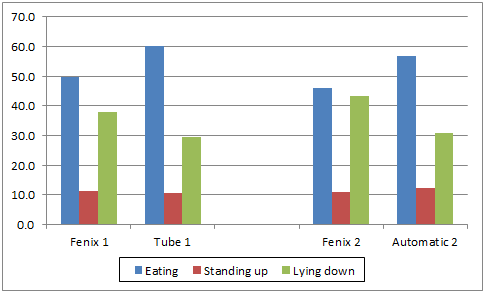



Feeder Preference of Broilers Investigated
Significant differences were observed in the behaviour of broilers using a new type of feeder compared to conventional tube and automatic types, according to experiments carried out in Brazil.Researchers at the School of Agriculture Engineering at the University of Campinas (UNICAMP) in Brazil have investigated the feeding behaviour of broilers with different types of feeder.
In their paper published in Revista Brasileira de Ciência Avícola, D.P. Neves and colleagues explain that their study compared three types of feeders for broilers: Fênix, tube and automatic feeders.
Tube and automatic feeders tested were of a conventional type, widely used in commercial broiler production, the researchers explained. The Fênix feeder was a manual feeder developed by Neves and Trevisan and still at the testing and simulation phase. It differs from manual feeders, mainly in relation to handling and ergonomics, which allow the feeder to be used throughout growing, without the need for a special equipment for very young chicks. This feeder has a partition grid above the plate for the growing and finishing phases but this can be removed for the first few days to allow young chicks easy access to the feed. The automatic feeder also incorporated a grid partition on the trough.
The birds' feeding behaviour and preference were evaluated from three weeks of age; preferences were assessed by examining birds' behavioural activities, such as eating, standing and lying around the equipment, and meal duration as function of the environmental variables.
Data on the behavioural activities and meal size were collected in a broiler commercial farm using a portable video camera, and the direct footage was analysed. The time spent in each activity, feeding bout duration and time spent near the trough were statistically analysed using the test of means and medians. Pearson's correlation test was used to evaluate the relationship between ambient environmental data and the time of feeding. A prospective scenario was established and data were compared to it pair-wise.
Interactions were observed between environmental characteristics and the activities of feeding and resting during the experiment (Figures 1 and 2).

Percentage of birds performing each activity - feeding, standing and lying down
(The differences in behaviour between feeder types were all significantly different (P<0.05) except for standing with the Fenix and tube feeders.)

(The differences between the time of day were only statistically significant (P<0.05) for the Fenix feeder.)
Eating behaviour was more frequent in the area around the tube feeder. The duration of feeding time was higher when the birds used the tube feeder (214±28 seconds), followed by the use of the Fênix feeder (123±17 seconds) and the automatic feeder (77±29 seconds).
The researchers commented that eating was more frequent during the morning and at low ambient temperatures, with the exception of the birds surrounding the automatic feeder, which ate more frequently when environmental temperatures were high.
Eating bout and meal duration were generally higher for the tube feeder than the other two feeders, which Neves and colleagues suggested may be related to the fact that this feeder does not have the partition grid, allowing the bird full access to the feed.
Reference
Neves D.P., Nääs I.A., Vercellino R. do A. and de Moura D.J. 2010. Do broilers prefer to eat from a certain type of feeder? Rev. Bras. Cienc. Avic., 12(3):179-187
Further ReadingYou can view the full report by clicking here. |
October 2012











